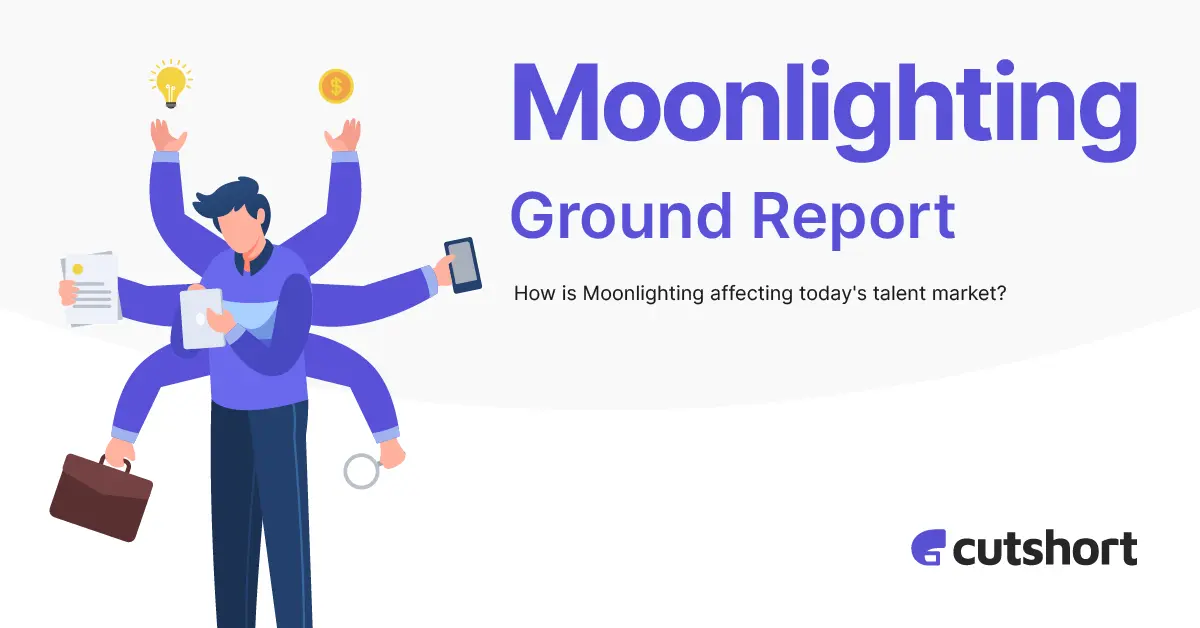How is Moonlighting affecting today’s talent market?
Executive Summary
Moonlighting, or working a second job or side gig in addition to one’s primary employment, is a topic that has generated debate in recent months. Cutshort conducted a survey to gain a deeper understanding of the experiences and attitudes of tech professionals toward moonlighting. The survey was completed by 3000 tech professionals with a diverse range of work experience, including individuals with 0-1 years of experience, 1-3 years of experience, and those with 3-7 years of experience. Results showed that only 22.91% of respondents claimed to have moonlighted in the past or are currently moonlighting, with 7.36% currently moonlighting.
The likelihood of moonlighting decreases as the experience level increases, with the lowest moonlighting among those with 3-7 years of experience. However, there was a surprising spike in moonlighting among those with 7-10 years of experience and those with more than 10 years of experience. The top reason for moonlighting was learning and applying new skills (83.59%) followed by building a professional network (52.89%). The intent to start their own business was a reason for 13.43% of respondents. The discussion around Moonlighting in the tech sector has been dichotomous, with some leaders considering it cheating while others openly announce their Moonlighting practices. Further discussions are needed to examine the ethics, legalities, and other considerations that come with Moonlighting.
Introduction
Moonlighting is the practice of taking up side hustles while you have a primary job. This phenomenon has recently been the topic of discussion in various industries, especially tech. While the debate was first sparked by Swiggy announcing a new policy that allows its delivery personnel to take on outside jobs or gigs, other companies soon joined the bandwagon and issued various statements about Moonlighting.
The Indian technology sector, with its $130 Billion industry, is at the forefront of this ongoing discourse. Discussions around “Moonlighting” has become ubiquitous, with numerous thought pieces and commentaries emerging from every corner of the tech industry.
The Moonlighting discourse in the tech world spread like wildfire after Wipro’s CEO Rishad Premji called Moonlighting “cheating and unacceptable”. Wipro followed this official statement with the lay-off of over 300 employees who were Moonlighting.
N Chandrasekaran, the chairman of Tata Sons said “We actively discourage Moonlighting because it can compromise the quality of work we deliver and can be a security risk”.
TCS also said that while they will go easy on the Moonlighting employees, they will not allow it. Infosys has asked employees to disclose and clarify any outside work they might be doing. As a result, many companies are now conducting background checks to ensure that potential hires are not already engaged in Moonlighting. Even the IT minister of Karnataka has come out saying that this practice is “literally cheating”.
However, not everyone has a negative opinion of Moonlighting. Rajeev Chandrasekhar, India’s minister of state for electronics and IT supports this practice. He says that this era of the Indian workforce has seen a structural shift in the attitudes of tech professionals.
Even Tech Mahindra has supported Moonlighting by saying that they may consider creating a policy that will allow employees to have other jobs as long as “someone is meeting the efficiency and productivity norms”.
However, despite the plethora of opinions offered by tech executives and fledging entrepreneurs alike, the conversation lacks a deeper examination of the underlying complexities. Unfortunately, empirical research examining the psychological and practical motivations and challenges faced by those who engage in Moonlighting, as well as those who do not, is often elusive.
At Cutshort, we aim to fill that gap. Hence, we have conducted a survey to gain a deeper understanding of the experiences and attitudes of tech professionals towards Moonlighting. The survey results are both insightful and thought-provoking, affording us a revealing window into the current state of the sector. Our study shed light on employees’ motivations for Moonlighting, its pros and cons, effects on individual skill development, overall workforce attitude towards it, and more.
Our survey participants were made of 3000+ tech professionals with a diverse range of work experience, including individuals who are just starting out with 0-1 year of experience, those with 1-3 years of experience, and those who have been in the industry for 3-7 years. We also received several responses from participants with 7-10 years of experience and a significant number of professionals with 10+ years of experience. The survey had a completion rate of 54.7% and took an average of 2.5 minutes to complete, indicating that this topic is of interest to tech professionals of various levels and years of experience.
The results gave us a glimpse into the current state of the professional market.
Unlocking the mysteries of the ‘Moonlighting’ phenomenon: Providing answers to the pertinent questions
There are several questions that the Moonlighting discussion poses, the first one being
What percentage of the workforce is Moonlighting?
What percentage of the workforce has tried Moonlighting? What percentage is sticking with it? And more importantly, is the number big enough to justify strong reactions of major corporations towards them?
And the question that follows is – who exactly is Moonlighting?
Can we find a pattern in the type of people who go for it? Are there a few factors common in most of them?
Let’s start with the basic questions about the Moonlighting landscape.
How many professionals are Moonlighting?
Recent studies indicate an emerging trend of professionals who are opting for Moonlighting.
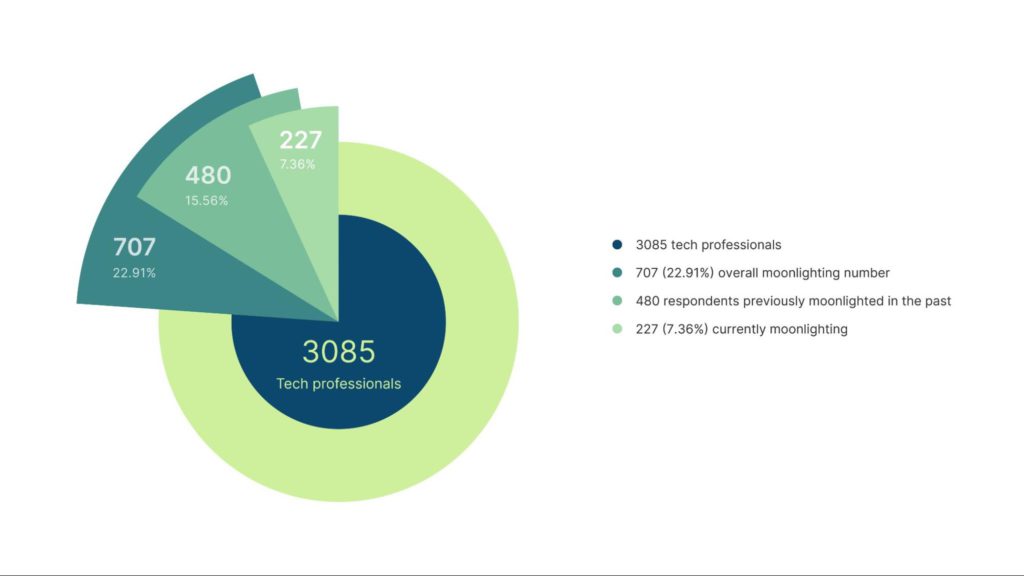
Out of the 3085 tech professionals we surveyed, 707 (22.91%) claimed that they have either Moonlighted in the past or are currently Moonlighting. Among the 707 respondents, 227 respondents are currently Moonlighting (just 7.36% of total respondents). And 480 respondents have previously been involved in projects outside their jobs (15.56% of the total respondents).
Who exactly is taking up side hustles?
There is a pattern to be seen in the Moonlighting demographic – experience level influences the likelihood of taking up side hustles.

Almost 31% of respondents with 0-1 years of experience were involved in Moonlighting. This phenomenon might be attributed to the fact that young individuals are inclined towards Moonlighting as a means of augmenting their primary source of income, leveraging their youthful vitality and adaptable schedules, or seeking to broaden their skill set and broaden their career prospects.
Then, as the experience level increases, Moonlighting gets less popular. Moonlighting was lowest for individuals with 3-7 years of experience.
Experienced workers could be less likely to Moonlight due to factors such as higher earning potential, job security, focus on work-life balance, and career advancement. These reasons may vary from person to person, and some may still choose to Moonlight for additional income or personal fulfillment.
However, there’s a surprising spike in Moonlighting among workers with experience of 7-10 years and greater than 10 years.
While we cannot say with absolute certainty what might be the cause of this spike, we can theorize a few possible reasons
- The 7+ years of experience candidates may be specialists in their field. Hence, their skills would be in very high demand. they might also have been able to build a professional brand and network over the years which will make it easy for them to find freelance opportunities.
- With more experience comes higher efficiency. As tech professionals gained more experience, they must have also gained more autonomy in their workplace. This must have made it easier for them to balance their primary job with freelance work.
- Experienced workers may have reached a plateau in their current roles or may be seeking new challenges that are not available in their current job. Moonlighting can provide a way for them to explore new opportunities without leaving their current job.
- The rise of the gig economy and the increased availability of freelance work may make it easier and more attractive for experienced workers to take on side gigs and Moonlighting opportunities.
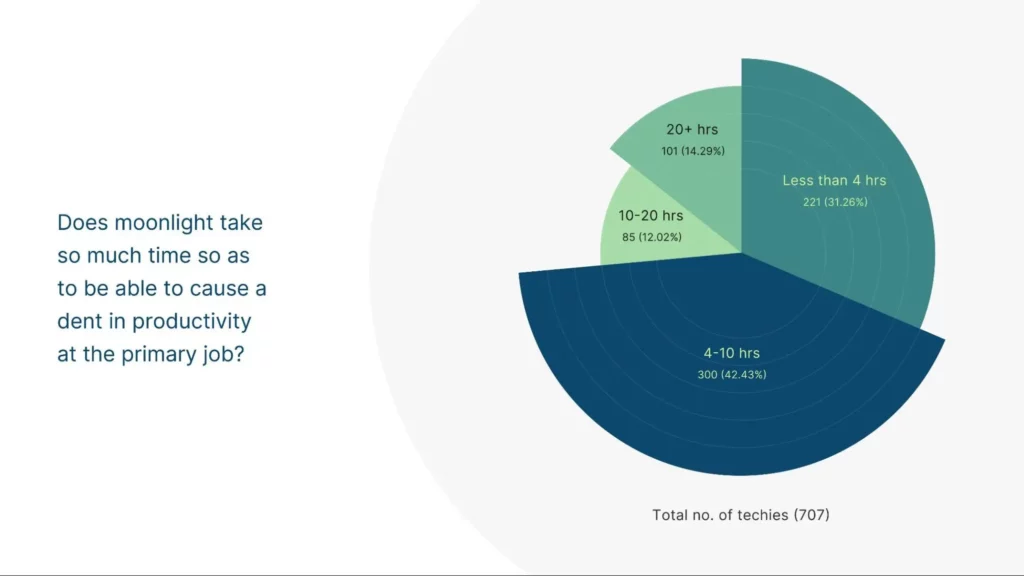
Does Moonlighting take so much time so as to be able to cause a dent in productivity at the primary job?
In the total pool of 707 respondents, close to 73.69% (521) of respondents are spending less than 10 hours Moonlighting per week. 4-10 hours/week is the most populated range of respondents.
Now that we know what the Moonlighting landscape looks like in India, let’s try to answer more pertinent questions that are nagging the minds of all tech recruiters and professionals.
Let’s start with the motivations behind the practice.
Understanding motivations: Why do people take up side hustles?
The next mystery of the Moonlighting discourse is understanding the motivations behind pursuing side hustles.
In theory, money comes off as the most obvious motivator. It seems like the most powerful reason why people would sacrifice their hard-earned free time to do another job. However, our research points in a few other directions.
In our survey, every individual who has Moonlighted or is currently Moonlighting was asked to select two reasons for taking up side hustles. One was chosen as the main reason and the other was chosen as an additional reason.
While earning an additional income was a popular answer for all experience levels with 47% of respondents with more than 7 years of experience and 47% of the respondents with 0-7 years of experience choosing additional income as a reason, learning and applying new skills emerged as the top reason for Moonlighting with 73.41% of the respondents choosing it as their reason.
Another reason trumped ‘earning an additional income’ as a favorite. More than half of the respondents (52.89%) mentioned building a professional network as their reason for Moonlighting. It was the second reason for almost 98% of respondents.
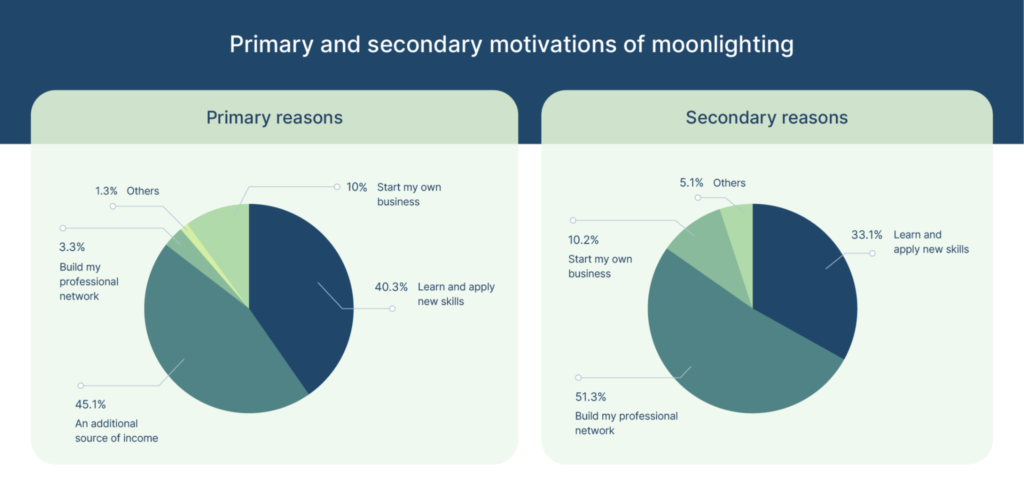
About 13.43% of respondents mentioned the intent to start their own business as one of the reasons for Moonlighting.
What Moonlighting means for tech companies: Ethics, legalities, and other considerations?
Now we know why professionals choose to Moonlight, if at all. So naturally, now it is important to inspect how it affects organizations.
The discussion around Moonlighting so far has been majorly dichotomous in the tech sector. One faction of tech leaders say that Moonlighting is wrong. Rishad Premji says that “Moonlighting is cheating, plain and simple,” while Swiggy and Tech Mahindra have come out supporting it. However, very few but prominent business leaders have stepped forward to back up the controversial practice.
For instance, Krish Gopalakrisnan, the co-founder of Infosys said with respect to Moonlighting that “As long as it doesn’t interfere with the employee’s performance or the interests of the company, we don’t see it as a problem.”
Taking a more balanced approach to support the practice, Shailendra Singh, the Managing Director of Sequoia Capital India & SEA said that “It’s a free country and people have the right to do what they want in their free time, but they should not use company resources, time or intellectual property for personal gains.”
Rajan Anandan said (when he was Managing Director of Google India) that they don’t have a policy against Moonlighting, “but we do expect our employees to put their primary job first and ensure that their side projects don’t conflict with the interests of the company”. This statement seemed to condone, if not defend, Moonlighting if it were practiced ethically.
The ethics of the existence of Moonlighting and whether it is cheating or not is a long discussion and a debate for another time. However, what we can do right now is explore the possible ways in which Moonlighting affects primary employers.
The problems that can arise from Moonlighting for tech companies
Let’s first discuss the issues that Moonlighting can possibly cause potential employers.
- Decrease in employee productivity as employees spend too much time on the side hustle.
- Legal and ethical issues.
- Increased fatigue and absenteeism in employees owing to the loss of work-life balance.
- Conflict of interest arising from an employee working for a competitor.
- Data breaches.
- Misuse of company resources.
Looking for solutions for the problems: Best practices for employers who are dealing with Moonlighting
- Decrease in employee productivity, increase in fatigue and absenteeism due to lack of work-life balance
Our studies show that this concern, while it may be backed by anecdotal evidence, is not based on concrete research. According to our research, in a pool of 707 respondents, 73.69% say that they spend less than 10 hours per week in Moonlighting with 4-10 hours being the most populated range of respondents. That comes down to less than 1 hour per day per week.
Among the respondents who are spending more than 10 hours Moonlighting (187), 158 (84.49%) of them had learning and applying new skills as a motivation to Moonlight and only 73 (39.03%) had additional income as a motivation. This suggests that if these individuals do not Moonlight, they will engage in other skill-building activities and their time will be utilized there instead.
Among the respondents with more than 10 years of experience, and who have also been involved in Moonlighting, 41.94% (highest in any experience category) of respondents spend less than 4 hours per week Moonlighting, a figure much higher than the average 15% for the whole sample. - Legal and ethical considerations of Moonlighting
Dual employment has to tiptoe around the fine line of ethics and law.
Legal considerations
Moonlighting is legal in India. There are no specific laws that prohibit individuals from holding more than one job, as long as they fulfill their responsibilities and obligations in each job. However, some companies may have policies in place that regulates or prohibits their employees from Moonlighting, especially if it interferes with their primary job responsibilities.
It is important for individuals to check with their primary employer and understand any policies or restrictions before starting a second job. Additionally, they should ensure that they comply with tax laws and regulations related to multiple sources of income.
Ethical considerations
Moonlighting treads into an ethical gray area as well with several ethical problems. Along with data security and misuse of resources, Moonlighting can affect workplace fairness to coworkers and reporting and tax implications. It can be perceived as unfair to coworkers if they are expected to pick up the slack while they employ Moonlighters, or if they do not have the opportunity to supplement their income in the same way.
Additionally, Moonlighting income may need to be reported to the Government for tax purposes, and employees must ensure they are following all relevant laws and regulations.
These ethical considerations must be carefully considered by employees before engaging in Moonlighting.
It is imperative for individuals who Moonlight to disclose their earnings to the Government. It might also help to disclose the predicted number of Moonlighting hours per week to the primary employers so they can ensure your schedule does not clash with their timings. - Conflict of interest arising from an employee working for a competitor
This is a major issue that tech companies face while dealing with Moonlighting. It is also probably the biggest ethical dilemma that needs to be addressed in this scenario. - Misuse of company resources and data breaches
Employees may sometimes use company-given devices and resources to perform side jobs. This not only puts the employee in an ethical gray area but can also make the company’s data vulnerable to breaches and leaks.
The solution to these problems is simple – but is it being used? Let’s see what our study says
The most obvious (and currently accepted) solution to the Moonlighting problem is for primary employers to introduce a detailed Moonlighting policy. Employers need to be clear on what they expect from their employees and set out guidelines that will help keep things above board.
Additionally, employers should provide education about conflict of interest policies that pertain to company confidential information so that employees understand what they can and cannot do while Moonlighting.
While the introduction of a company policy remains the easiest and most prominent way to safeguard an organization against issues, not many companies have them. And even if they do, they do not communicate their policies to the employees effectively.
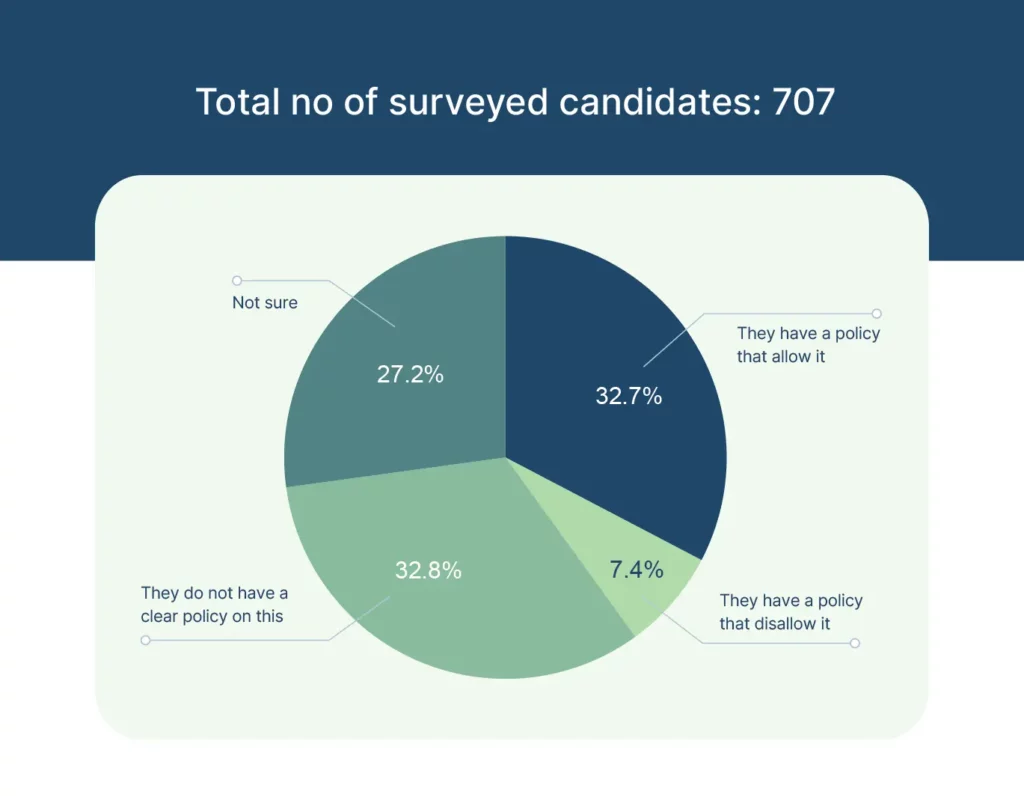
According to our research, a large portion of the 707 respondents who Moonlight or have Moonlighted (32.67% and 44.85%, if we remove the not sure responses), mentioned that their companies allow Moonlighting and the same proportion of respondents said that their company does not have a clear policy for Moonlighting (232 respondents said that their companies allow Moonlighting).
52 respondents (1.69% of total respondents) are Moonlighting even after their company policy disallows it.
Almost 60% of respondents said either they are not sure about the company’s policy on Moonlighting (27.16%) or the company does not have a clear policy on Moonlighting (32.81%). This indicates a huge lack of clarity from both employer and the employee end.
A Guide for the policymakers
We know that developing a Moonlighting policy and effectively communicating it with employees can safeguard an organization against most challenges that arise due to dual employment.
However, making that policy and complying with it is not always easy, especially for large businesses. So here are a few touchpoints you can start with while introducing or modifying your policy.
- Assess the company’s needs and goals: Determine the purpose and objectives of the policy and how it aligns with the company’s overall goals and values.
- Review relevant laws and regulations: Ensure that the policy complies with all relevant employment laws and regulations, including those related to overtime, fair labor practices, and tax obligations.
- Define Moonlighting: Clearly define what is considered Moonlighting and the types of secondary employment that are permitted or prohibited.
- Establish reporting requirements: Require employees to report any secondary employment to the company, including the type of work, the employer, and the number of hours worked.
- Address conflicts of interest: Outline how conflicts of interest will be handled, such as prohibiting secondary employment that is in direct competition with the company or that requires the use of confidential information.
- Consider the impact of performance: Consider the potential impact that Moonlighting may have on an employee’s performance, health, and well-being, and establish guidelines for managing these risks.
What the funnel might hold
Moonlighting is becoming more prevalent in the tech industry, driven by factors such as the high demand for tech talent, the increase in remote work opportunities, and the rise of the gig economy. Companies are faced with the challenges of managing Moonlighting in a way that balances the needs and interests of both the employees and the organization.
Moonlighting is expected to grow both in terms of numbers and popularity. Here are a few reasons why we think Moonlighting is going to gain more momentum in the coming years.
- Tech advancements: Technological advancements may create new opportunities for Moonlighting, such as online platforms and tools that make it easier for employees to find and apply for secondary jobs.
- Changes in employment laws: Changes in employment laws and regulations may impact the Moonlighting industry, such as laws related to overtime pay, tax obligations, and worker classification.
- Increased awareness: Companies are likely to become more aware of Moonlighting and its potential impact on their operations and employees. Some companies may choose to restrict or prohibit Moonlighting, while others may adopt more flexible policies that encourage it.
- Continued growth: The Moonlighting industry is likely to continue to grow, driven by factors such as the increasing demand for skilled workers, the rise of gig economy, and the trend toward remote work.
Our research also shows that if candidates have spent a higher number of years working for the same company, they are less likely to Moonlight. This means that a new and younger workforce is more likely to Moonlight. The tech sector in India has lately reported an increase in turnover rates due to the high demand for skilled workers and the availability of alternative employment opportunities. This might also point to a possible increase in Moonlighting.
Conclusion
Moonlighting is an evolving trend in India, especially post-COVID-19. With the recent growth in the popularity of work-from-home jobs and startup culture, this concept may receive stronger support in the future. That said, the legality depends on the company’s policy, the nature of employment, and other factors involved in a work environment.
This survey has helped us to associate quantifiable metrics with many key parameters and draw conclusions about certain trends like the experience-Moonlighting likelihood. It has also helped us understand the motivations of professionals behind taking up side hustles and the current state of Moonlighting policies in the tech world.
Although we cannot accurately predict upcoming Moonlighting trends in the tech sector, there are a few factors that point to an increase in its popularity.
Get this and similar reports delivered to your inbox
Give us an address we can reach you and we’ll deliver this and all our future reports directly to your inbox.


